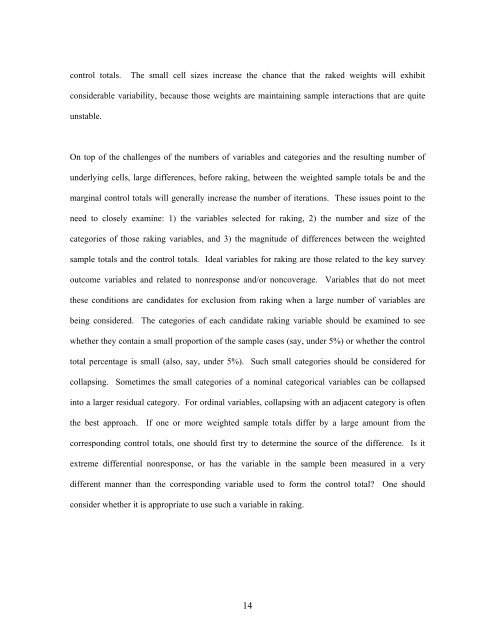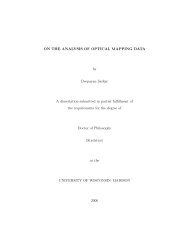Practical Considerations in Raking Survey Data
Practical Considerations in Raking Survey Data
Practical Considerations in Raking Survey Data
You also want an ePaper? Increase the reach of your titles
YUMPU automatically turns print PDFs into web optimized ePapers that Google loves.
control totals. The small cell sizes <strong>in</strong>crease the chance that the raked weights will exhibit<br />
considerable variability, because those weights are ma<strong>in</strong>ta<strong>in</strong><strong>in</strong>g sample <strong>in</strong>teractions that are quite<br />
unstable.<br />
On top of the challenges of the numbers of variables and categories and the result<strong>in</strong>g number of<br />
underly<strong>in</strong>g cells, large differences, before rak<strong>in</strong>g, between the weighted sample totals be and the<br />
marg<strong>in</strong>al control totals will generally <strong>in</strong>crease the number of iterations. These issues po<strong>in</strong>t to the<br />
need to closely exam<strong>in</strong>e: 1) the variables selected for rak<strong>in</strong>g, 2) the number and size of the<br />
categories of those rak<strong>in</strong>g variables, and 3) the magnitude of differences between the weighted<br />
sample totals and the control totals. Ideal variables for rak<strong>in</strong>g are those related to the key survey<br />
outcome variables and related to nonresponse and/or noncoverage. Variables that do not meet<br />
these conditions are candidates for exclusion from rak<strong>in</strong>g when a large number of variables are<br />
be<strong>in</strong>g considered. The categories of each candidate rak<strong>in</strong>g variable should be exam<strong>in</strong>ed to see<br />
whether they conta<strong>in</strong> a small proportion of the sample cases (say, under 5%) or whether the control<br />
total percentage is small (also, say, under 5%). Such small categories should be considered for<br />
collaps<strong>in</strong>g. Sometimes the small categories of a nom<strong>in</strong>al categorical variables can be collapsed<br />
<strong>in</strong>to a larger residual category. For ord<strong>in</strong>al variables, collaps<strong>in</strong>g with an adjacent category is often<br />
the best approach. If one or more weighted sample totals differ by a large amount from the<br />
correspond<strong>in</strong>g control totals, one should first try to determ<strong>in</strong>e the source of the difference. Is it<br />
extreme differential nonresponse, or has the variable <strong>in</strong> the sample been measured <strong>in</strong> a very<br />
different manner than the correspond<strong>in</strong>g variable used to form the control total? One should<br />
consider whether it is appropriate to use such a variable <strong>in</strong> rak<strong>in</strong>g.<br />
14
















